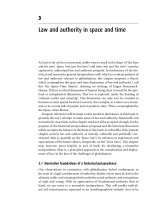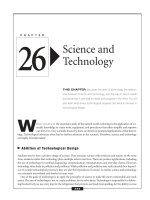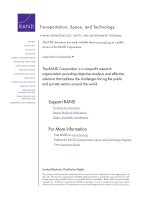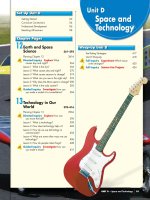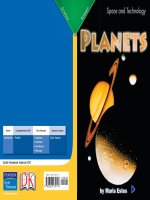4 19 great inventions (space and technology)
Bạn đang xem bản rút gọn của tài liệu. Xem và tải ngay bản đầy đủ của tài liệu tại đây (2.74 MB, 10 trang )
Genre
Nonfiction
Comprehension Skill
Main Idea and Details •
•
•
•
Text Features
Captions
Labels
Text Boxes
Glossary
Science Content
Technology
Scott Foresman Science 4.19
ISBN 0-328-13915-7
ì<(sk$m)=bdjbfg< +^-Ä-U-Ä-U
Vocabulary
Extended Vocabulary
communication
optical fibers
technology
telecommunications
vehicle
carbonized
device
filament
graphics
hover
portable
projector
transistor
Picture Credits
Every effort has been made to secure permission and provide appropriate credit for photographic material.
The publisher deeply regrets any omission and pledges to correct errors called to its attention in subsequent editions.
Photo locators denoted as follows: Top (T), Center (C), Bottom (B), Left (L), Right (R), Background (Bkgd).
Opener: The Science Musuem/©DK Images; 1 ©Bettmann/Corbis; 4 (B, BR) Getty Images; 5 (BR) The Cinema Museum/
Ronald Grant Archive; 6 (TL) ©Bettmann/Corbis, (BL) The Science Musuem/©DK Images; 7 (T) Schenectady Museum/Hall
of Electrical History Foundation/Corbis, (CR) Brand X Pictures; 8 (TL) ©Bettmann/Corbis, (B) Science Museum, London/
DK Images; 9 (TR) Alfred Pasieka/Photo Researchers, Inc.; 10 (TL) ©Bettmann/Corbis; 11 (CR) Reuters/Corbis; 12 (TL)
©Bettmann/Corbis, (B) Science Source/Photo Researchers, Inc.; 14 (TL) Hulton-Deutsch Collection/Corbis.
Scott Foresman/Dorling Kindersley would also like to thank: 11 (TL) Museum of the Moving Image/DK Images.
Unless otherwise acknowledged, all photographs are the copyright © of Dorling Kindersley, a division of Pearson.
ISBN: 0-328-13915-7
Copyright © Pearson Education, Inc. All Rights Reserved. Printed in the United States of America.
This publication is protected by Copyright, and permission should be obtained from the publisher prior to any
prohibited reproduction, storage in a retrieval system, or transmission in any form by any means, electronic,
mechanical, photocopying, recording, or likewise. For information regarding permission(s), write to
Permissions Department, Scott Foresman, 1900 East Lake Avenue, Glenview, Illinois 60025.
3 4 5 6 7 8 9 10 V010 13 12 11 10 09 08 07 06 05
What did you learn?
1. How is a filament used in a light bulb?
2. How have movies changed over the past
one hundred years?
by Patricia Walsh
3. What can helicopters do that airplanes
cannot do?
4.
The invention of
the transistor changed how computers
were made and used. Describe how the
transistor did this. Use details from the
book to support your answer.
5.
Main Idea and Details What
are some details that help you
understand how Alexander Graham
Bell’s telephone worked?
What You Already Know
Technology helps us solve
problems and makes our
work easier and more efficient.
It also helps us live healthier
and safer lives. Technology has
helped make a sport such as
in-line skating safer. In-line
skates are made from materials
that people have made from
natural resources. Iron ore is a
natural resource that is used to make the screws that hold
an in-line skate’s wheels in place. The plastic found on
an in-line skate is made from chemicals found in nature.
Technology has improved medical care. Optical
fibers are thin tubes that allow light to pass. They help
doctors see inside the body. X-ray machines take pictures
of bones in the body. Another diagnostic tool is magnetic
resonance imaging, also known as MRI. It also allows
doctors to get a detailed look inside the body so they can
identify problems.
Radio, TV, the telephone, the Internet, and e-mail
help us communicate faster and across greater distances.
Communication is any way of sending a message
from one place to another. There are many ways
to communicate.
2
Telecommunications are communications made
electronically over a distance. We can communicate with
people around the world, with astronauts, and with
spacecraft in outer space.
Today’s transportation vehicles include cars, trucks,
and airplanes. A vehicle carries people and goods.
Transportation technology moves people and goods
from place to place. Today through new technology,
engineers make transportation safer and more efficient.
Science and technology have improved because
many people have been curious about how things work
and about ways to make them better. In this book you
will read about inventors and their inventions that
changed our world.
3
Changing the World
Technology of our modern age is due to the
discoveries and inventions of inventors of the past.
Over the past two hundred years, the way we live and
communicate with one another has changed so much!
The inventions of the telephone and the computer
have changed how we send and receive information.
Today we can pick up the phone and speak to a friend
living on the other side of the world. We
can send an e-mail to our next-door
neighbor or even to astronauts in space.
How to use electricity was a very
important discovery. Think of how
important electricity is to our everyday
lives! Without electricity, we would
not be able to do so many of the
things we do each day.
light bulb
airplane
The movies that entertained people in the early
1900s were just flickering black-and-white images with
no sound. Today we are thrilled with colorful animation
and special effects.
Pioneers traveled across the country in wagons or on
foot. The invention of powered flight and the airplane
made big changes in how we travel. Now crossing the
United States takes only a few hours instead of a few
months. The credit for these advancements goes to
amateur and professional scientists and inventors.
computer
telephone
4
movie theater
5
A Bright Idea
Thomas Edison
Before Thomas Edison and his
team of inventors improved the light
bulb, city streets were lit with the
flicker of gas lamps. Thomas Edison
was a scientist and inventor who
wanted the streets to be lit by electric
bulbs. Edison and his team of scientists
took a horseshoe-shaped filament, or
wire, made of carbonized thread and
heated it with an electric current. They
found it would glow for several hours
inside a glass globe. Edison had his
assistants string up these new electric
lights outside his research laboratory
in Menlo Park, New Jersey.
The night of December 31, 1879
was Edison’s first public demonstration
of these lights powered by electricity. A
few dozen electric lamps glowed above
the heads of three thousand spectators.
The people had never seen anything
quite like it.
This version of Edison’s lamp
was made in 1880.
6
Pearl Street Power Station provided
electricity to homes and businesses
in New York.
Neon Lights
Edison wanted a safe,
affordable, practical system that
would bring electricity to
people’s homes. He invented the
electric meter. He planned the
Pearl Street Power Station in
New York City, the first power
plant to generate electricity. By
the end of the 1880s, everyone
in New York had access to
Edison’s electricity.
Today neon lights
are often used in
advertising signs. Neon
is a colorless, odorless
gas. An electric current
passing through tubes
filled with neon causes
the colored light.
Many light bulbs still
look much like Edison’s.
7
The Telephone
Optical Fibers
Alexander Graham Bell
invented the telephone in 1876.
He was interested in finding new
ways to transmit sound. With
Alexander
Graham Bell
Thomas Watson, Bell tried to make
electric currents imitate sound waves so people could
communicate over long distances. After many
experiments, Bell was finally able to speak with
Watson using the first telephone. The first words
spoken on the telephone were, “Mr. Watson, come
here. I want to see you.” Bell’s invention had used an
electric current to send the sound of a voice through
wires. His first telephone combined the earpiece and the
mouthpiece. It used a magnet to help transfer the sound.
earpiece and mouthpiece combined
Today many telephone
systems use the
technology of optical
fibers to transmit
telephone calls.
Information is
changed into light
pulses that are
carried by thin glass
or plastic filaments.
Modern telephones don’t look like
Bell’s invention, but they use the
same principles.
magnet
Bell’s first telephone was known as the “Box Telephone.”
8
In 1915 telephone lines crossing the country connected
America’s East and West Coasts. After telephone cables
were laid under oceans, people on different continents
could talk to one another for the first time.
Two technologies are combined to make today’s
cellular phone. They are Bell’s invention of the telephone
and Nikolai Tesla’s invention of the radio. The scientific
principles of these two inventions led to the development
of this form of wireless communication.
9
The Age
Of Film
color film
In the late 1800s Thomas Edison
invented a movie camera that he called
a Kinetoscope. It could record images
and then reproduce them. French inventors Louis and
Auguste Lumière first saw Edison’s Kinetoscope in
1894. The Lumière brothers had ideas about how to
improve it.
Within a year, they invented a combination movie
camera and movie projector. They called it the
Cinématographe. The first public demonstration of
this new technology was in Paris in
December 1895. It was more
portable than other cameras
of the time. It projected
images onto a screen
using a lens and a
light source.
Auguste and
Louis Lumière
Cinématographe
The development of a camera that could
record color changed cinema forever.
The Lumière brothers’ first movie was titled Workers
Leaving the Lumière Factory. Can you tell from the title
what the film was about?
In just a few months, the
Digital Animation
Cinématographe was in use all
over Europe. Soon movies
and moviemaking were
gaining popularity all over
the world. The first movies
were black and white. By the
1940s the technology was
Digital animation is
available for movies to be
a series of moving
made in color. Today films
images made on a
are more and more advanced
computer screen. It can
with computer graphics and
be as simple as a moving
special effects that entertain
shape or as detailed
as the 3-D animation
and inform us.
in full-length movies.
10
11
Taking To
The Sky
Wilbur and Orville Wright worked
in their Ohio bicycle shop, picturing the
day that people would fly. They used
their knowledge of mathematics and
Wilbur and
mechanics to design a vehicle that
Orville Wright
would fly. From 1900 to 1903, they
experimented with gliders and powered aircraft in the
windy hills near Kitty Hawk, North Carolina. Then on
December 17, 1903, the Wright brothers flew the first
ever manned aircraft. Orville Wright was the pilot for
the first flight, which lasted just twelve seconds.
The first powered flight took place
at Kitty Hawk, North Carolina.
Airplanes have
revolutionized the
way we travel.
Later that day, Wilbur Wright flew for fifty-nine
seconds at a speed of thirty-one miles per hour. The
U.S. Army, seeing a future use of this new technology,
asked the Wright brothers to build a flying machine
that could travel with a
Helicopters
passenger at a speed of
forty miles per hour.
Now, just over one
hundred years later,
commercial jet airplanes
carry hundreds of
passengers and cargo at a
A helicopter with its
speed of six hundred miles
rotary blades can be
per hour. What do you
flown almost anywhere.
think the Wright brothers
It can do three things an
would say about today’s
airplane cannot do. It can
fly backward, rotate in
busy airports?
the air, and hover.
12
13
The Computer
Age
Charles Babbage, a British
mathematician, was far ahead of his
time. In 1834, he had an idea for a
programmable computer that would
solve math problems faster than humans
Charles Babbage could. Although his Analytical Engine
was never completed, his idea helped
lead to the development of the modern computer.
Many years later, in 1947, three scientists at Bell
Telephone Laboratories searched for a way to process
information quickly. John Bardeen, Walter Brattain, and
William Shockley built on
the ideas of earlier scientists
and invented a tiny device
called a transistor. A
transistor controls the flow
of electricity in electronic
equipment. One of the first
uses of transistors was in
hearing aids that were small
enough to fit into the ear.
In 1955 scientists at
Bell Labs designed the
first computer that had a
transistor. Until then, a
computer took up an entire
room. This new computer
was faster and smaller than
the room-sized computer
it replaced. Today our
computers and handheld
devices are even smaller, yet
faster and more powerful.
What do you think the
next important invention
will be? Do you think it
will change the world?
The Internet
The Internet is a global
network that connects
millions and millions of
computers and computer
users through wires,
cables, and satellites. It
allows people everywhere
to gather and exchange
information, news,
and opinions.
Today’s computers have
many uses.
Babbage’s Analytical Engine was
a huge technological advancement.
14
15
Vocabulary
Glossary
communication
Extended Vocabulary
carbonized
optical fibers
device
technology
filament
carbonized
changed into
carbon by burning
telecommunications
graphics
vehicle
hover for a particular
device
something invented
portable
use or purpose
projector
transistor
filament
threadlike wire
that glows when electric
current is passed through it
graphics
drawings or pictures
hover
to hang or float near the same place in
the air
portable
easily carried
Picture Credits
Every effort has been made to secure permission and provide appropriate credit for photographic material.
The publisher deeply regrets any omission and pledges to correct errors called to its attention in subsequent editions.
projector
a machine that sends out an image
onto a screen
Photo locators denoted as follows: Top (T), Center (C), Bottom (B), Left (L), Right (R), Background (Bkgd).
Opener: The Science Musuem/©DK Images; 1 ©Bettmann/Corbis; 4 (B, BR) Getty Images; 5 (BR) The Cinema Museum/
Ronald Grant Archive; 6 (TL) ©Bettmann/Corbis, (BL) The Science Musuem/©DK Images; 7 (T) Schenectady Museum/Hall
of Electrical History Foundation/Corbis, (CR) Brand X Pictures; 8 (TL) ©Bettmann/Corbis, (B) Science Museum, London/
DK Images; 9 (TR) Alfred Pasieka/Photo Researchers, Inc.; 10 (TL) ©Bettmann/Corbis; 11 (CR) Reuters/Corbis; 12 (TL)
©Bettmann/Corbis, (B) Science Source/Photo Researchers, Inc.; 14 (TL) Hulton-Deutsch Collection/Corbis.
transistor
a small device that controls the flow
of electricity in electronic equipment
Scott Foresman/Dorling Kindersley would also like to thank: 11 (TL) Museum of the Moving Image/DK Images.
Unless otherwise acknowledged, all photographs are the copyright © of Dorling Kindersley, a division of Pearson.
ISBN: 0-328-13915-7
Copyright © Pearson Education, Inc. All Rights Reserved. Printed in the United States of America.
This publication is protected by Copyright, and permission should be obtained from the publisher prior to any
prohibited reproduction, storage in a retrieval system, or transmission in any form by any means, electronic,
mechanical, photocopying, recording, or likewise. For information regarding permission(s), write to
Permissions Department, Scott Foresman, 1900 East Lake Avenue, Glenview, Illinois 60025.
3 4 5 6 7 8 9 10 V010 13 12 11 10 09 08 07 06 05
16
What did you learn?
1. How is a filament used in a light bulb?
2. How have movies changed over the past
one hundred years?
3. What can helicopters do that airplanes
cannot do?
4.
The invention of
the transistor changed how computers
were made and used. Describe how the
transistor did this. Use details from the
book to support your answer.
5.
Main Idea and Details What
are some details that help you
understand how Alexander Graham
Bell’s telephone worked?
